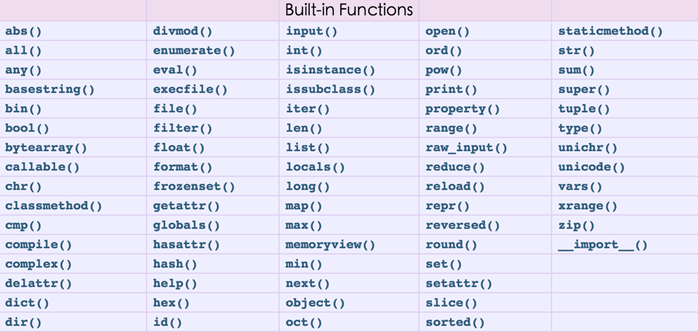专栏目录:
Python爬虫与数据分析之python教学视频、python源码分享,python
Python爬虫与数据分析之基础教程:Python的语法、字典、元组、列表
Python爬虫与数据分析之进阶教程:文件操作、lambda表达式、递归、yield生成器
Python爬虫与数据分析之模块:内置模块、开源模块、自定义模块
Python爬虫与数据分析之爬虫技能:urlib库、xpath选择器、正则表达式
Python爬虫与数据分析之京东爬虫实战:爬取京东商品并存入sqlite3数据库
Python爬虫与数据分析之python开源爬虫项目汇总
python常用内置函数:

文件操作
操作文件时,一般需要经历如下步骤:
- 打开文件
- 操作文件
- 关闭文件
一、打开文件
|
1 |
|
注:python中打开文件有两种方式,即:open(...) 和 file(...) ,本质上前者在内部会调用后者来进行文件操作,推荐使用 open。
打开文件时,需要指定文件路径和以何等方式打开文件,打开后,即可获取该文件句柄,日后通过此文件句柄对该文件操作。
打开文件的模式有:
- r,只读模式(默认)。
- w,只写模式。【不可读;不存在则创建;存在则删除内容;】
- a,追加模式。【可读; 不存在则创建;存在则只追加内容;】
"+" 表示可以同时读写某个文件
- r+,可读写文件。【可读;可写;可追加】
- w+,写读
- a+,同a
"U"表示在读取时,可以将 \r \n \r\n自动转换成 \n (与 r 或 r+ 模式同使用)
- rU
- r+U
"b"表示处理二进制文件(如:FTP发送上传ISO镜像文件,linux可忽略,windows处理二进制文件时需标注)
- rb
- wb
- ab
二、操作函数

1 class file(object): 2 3 def close(self): # real signature unknown; restored from __doc__ 4 关闭文件 5 """ 6 close() -> None or (perhaps) an integer. Close the file. 7 8 """ 9 10 def fileno(self): # real signature unknown; restored from __doc__ 11 文件描述符 12 """ 13 fileno() -> integer "file descriptor". 14 15 This is needed for lower-level file interfaces, such os.read(). 16 """ 17 return 0 18 19 def flush(self): # real signature unknown; restored from __doc__ 20 刷新文件内部缓冲区 21 """ flush() -> None. Flush the internal I/O buffer. """ 22 pass 23 24 25 def isatty(self): # real signature unknown; restored from __doc__ 26 判断文件是否是同意tty设备 27 """ isatty() -> true or false. True if the file is connected to a tty device. """ 28 return False 29 30 31 def next(self): # real signature unknown; restored from __doc__ 32 获取下一行数据,不存在,则报错 33 """ x.next() -> the next value, or raise StopIteration """ 34 pass 35 36 def read(self, size=None): # real signature unknown; restored from __doc__ 37 读取指定字节数据 38 """ 39 read([size]) -> read at most size bytes, returned as a string. 40 41 """ 42 pass 43 44 def readinto(self): # real signature unknown; restored from __doc__ 45 读取到缓冲区,不要用,将被遗弃 46 """ readinto() -> Undocumented. Don't use this; it may go away. """ 47 pass 48 49 def readline(self, size=None): # real signature unknown; restored from __doc__ 50 仅读取一行数据 51 """ 52 readline([size]) -> next line from the file, as a string. 53 """ 54 pass 55 56 def readlines(self, size=None): # real signature unknown; restored from __doc__ 57 读取所有数据,并根据换行保存值列表 58 """ 59 readlines([size]) -> list of strings, each a line from the file. 60 """ 61 return [] 62 63 def seek(self, offset, whence=None): # real signature unknown; restored from __doc__ 64 指定文件中指针位置 65 """ 66 seek(offset[, whence]) -> None. Move to new file position. 67 """ 68 pass 69 70 def tell(self): # real signature unknown; restored from __doc__ 71 获取当前指针位置 72 """ tell() -> current file position, an integer (may be a long integer). """ 73 pass 74 75 def truncate(self, size=None): # real signature unknown; restored from __doc__ 76 截断数据,仅保留指定之前数据 77 """ 78 pass 79 80 def write(self, p_str): # real signature unknown; restored from __doc__ 81 写内容 82 """ 83 write(str) -> None. Write string str to file. 84 """ 85 pass 86 87 def writelines(self, sequence_of_strings): # real signature unknown; restored from __doc__ 88 将一个字符串列表写入文件 89 """ 90 writelines(sequence_of_strings) -> None. Write the strings to the file. 91 """ 92 pass 93 94 def xreadlines(self): # real signature unknown; restored from __doc__ 95 可用于逐行读取文件,非全部 96 """ 97 xreadlines() -> returns self. 98 """ 99 pass
三、with
为了避免打开文件后忘记关闭,可以通过管理上下文,即:
|
1 2 3 |
|
如此方式,当with代码块执行完毕时,内部会自动关闭并释放文件资源。
在Python 2.7 后,with又支持同时对多个文件的上下文进行管理,即:
|
1 2 |
|
四、python文件操作实例
自定义函数
一、背景
在学习函数之前,一直遵循:面向过程编程,即:根据业务逻辑从上到下实现功能,其往往用一长段代码来实现指定功能,开发过程中最常见的操作就是粘贴复制,也就是将之前实现的代码块复制到现需功能处,如下
|
1 2 3 4 5 6 7 8 9 10 11 12 13 14 15 16 17 18 |
|
腚眼一看上述代码,if条件语句下的内容可以被提取出来公用,如下:
|
1 2 3 4 5 6 7 8 9 10 11 12 13 14 15 |
|
对于上述的两种实现方式,第二次必然比第一次的重用性和可读性要好,其实这就是函数式编程和面向过程编程的区别:
- 函数式:将某功能代码封装到函数中,日后便无需重复编写,仅调用函数即可
- 面向对象:对函数进行分类和封装,让开发“更快更好更强...”
函数式编程最重要的是增强代码的重用性和可读性
二、 函数的定义和使用
|
1 2 3 4 5 |
|
函数的定义主要有如下要点:
- def:表示函数的关键字
- 函数名:函数的名称,日后根据函数名调用函数
- 函数体:函数中进行一系列的逻辑计算,如:发送邮件、计算出 [11,22,38,888,2]中的最大数等...
- 参数:为函数体提供数据
- 返回值:当函数执行完毕后,可以给调用者返回数据。
以上要点中,比较重要有参数和返回值:
1、返回值
函数是一个功能块,该功能到底执行成功与否,需要通过返回值来告知调用者。
2、参数
函数的有三中不同的参数:
- 普通参数
- 默认参数
- 动态参数
 View Code
View Code
lambda表达式
学习条件运算时,对于简单的 if else 语句,可以使用三元运算来表示,即:
|
1 2 3 4 5 6 7 8 |
|
对于简单的函数,也存在一种简便的表示方式,即:lambda表达式
|
1 2 3 4 5 6 7 8 9 10 11 12 13 14 15 |
|
lambda存在意义就是对简单函数的简洁表示
内置函数 二
一、map
遍历序列,对序列中每个元素进行操作,最终获取新的序列。

1 li = [11, 22, 33] 2 3 new_list = map(lambda a: a + 100, li) 4 5 6 li = [11, 22, 33] 7 sl = [1, 2, 3] 8 new_list = map(lambda a, b: a + b, li, sl)
二、filter
对于序列中的元素进行筛选,最终获取符合条件的序列

1 2 li = [11, 22, 33] 3 4 new_list = filter(lambda arg: arg > 22, li) 5 6 #filter第一个参数为空,将获取原来序列
三、reduce
对于序列内所有元素进行累计操作

li = [11, 22, 33] result = reduce(lambda arg1, arg2: arg1 + arg2, li) # reduce的第一个参数,函数必须要有两个参数 # reduce的第二个参数,要循环的序列 # reduce的第三个参数,初始值
yield生成器
1、对比range 和 xrange 的区别
|
1 2 3 4 |
|
如上代码所示,range会在内存中创建所有指定的数字,而xrange不会立即创建,只有在迭代循环时,才去创建每个数组。

1 def nrange(num): 2 temp = -1 3 while True: 4 temp = temp + 1 5 if temp >= num: 6 return 7 else: 8 yield temp
2、文件操作的 read 和 xreadlinex 的的区别
|
1 2 |
|

1 def NReadlines(): 2 with open('log','r') as f: 3 while True: 4 line = f.next() 5 if line: 6 yield line 7 else: 8 return 9 10 for i in NReadlines(): 11 print i 12 13 14 def NReadlines(): 15 with open('log','r') as f: 16 seek = 0 17 while True: 18 f.seek(seek) 19 data = f.readline() 20 if data: 21 seek = f.tell() 22 yield data 23 else: 24 return 25 26 for item in NReadlines(): 27 print item 28
装饰器
装饰器是函数,只不过该函数可以具有特殊的含义,装饰器用来装饰函数或类,使用装饰器可以在函数执行前和执行后添加相应操作。
|
1 2 3 4 5 6 7 8 9 10 |
|

1 import functools 2 3 4 def wrapper(func): 5 @functools.wraps(func) 6 def wrapper(): 7 print 'before' 8 func() 9 print 'after' 10 return wrapper 11 12 @wrapper 13 def foo(): 14 print 'foo' 15 16 17 #!/usr/bin/env python 18 #coding:utf-8 19 20 def Before(request,kargs): 21 print 'before' 22 23 def After(request,kargs): 24 print 'after' 25 26 27 def Filter(before_func,after_func): 28 def outer(main_func): 29 def wrapper(request,kargs): 30 31 before_result = before_func(request,kargs) 32 if(before_result != None): 33 return before_result; 34 35 main_result = main_func(request,kargs) 36 if(main_result != None): 37 return main_result; 38 39 after_result = after_func(request,kargs) 40 if(after_result != None): 41 return after_result; 42 43 return wrapper 44 return outer 45 46 @Filter(Before, After) 47 def Index(request,kargs): 48 print 'index' 49 50 51 if __name__ == '__main__': 52 Index(1,2) 53
冒泡算法
需求:请按照从小到大对列表 [13, 22, 6, 99, 11] 进行排序
思路:相邻两个值进行比较,将较大的值放在右侧,依次比较!

1 li = [13, 22, 6, 99, 11] 2 3 for m in range(4): # 等价于 #for m in range(len(li)-1): 4 if li[m]> li[m+1]: 5 temp = li[m+1] 6 li[m+1] = li[m] 7 li[m] = temp 8 9 10 li = [13, 22, 6, 99, 11] 11 12 for m in range(4): # 等价于 #for m in range(len(li)-1): 13 if li[m]> li[m+1]: 14 temp = li[m+1] 15 li[m+1] = li[m] 16 li[m] = temp 17 18 for m in range(3): # 等价于 #for m in range(len(li)-2): 19 if li[m]> li[m+1]: 20 temp = li[m+1] 21 li[m+1] = li[m] 22 li[m] = temp 23 24 for m in range(2): # 等价于 #for m in range(len(li)-3): 25 if li[m]> li[m+1]: 26 temp = li[m+1] 27 li[m+1] = li[m] 28 li[m] = temp 29 30 for m in range(1): # 等价于 #for m in range(len(li)-4): 31 if li[m]> li[m+1]: 32 temp = li[m+1] 33 li[m+1] = li[m] 34 li[m] = temp 35 print li 36 37 38 li = [13, 22, 6, 99, 11] 39 40 for i in range(1,5): 41 for m in range(len(li)-i): 42 if li[m] > li[m+1]: 43 temp = li[m+1] 44 li[m+1] = li[m] 45 li[m] = temp 46
递归
利用函数编写如下数列:
斐波那契数列指的是这样一个数列 0, 1, 1, 2, 3, 5, 8, 13, 21, 34, 55, 89, 144, 233,377,610,987,1597,2584,4181,6765,10946,17711,28657,46368

1 def func(arg1,arg2): 2 if arg1 == 0: 3 print arg1, arg2 4 arg3 = arg1 + arg2 5 print arg3 6 func(arg2, arg3) 7 8 func(0,1)
公告
更多python源码,视频教程,欢迎关注公众号:南城故梦
>零起点大数据与量化分析PDF及教程源码
>利用python进行数据分析PDF及配套源码
>大数据项目实战之Python金融应用编程(数据分析、定价与量化投资)讲义及源码
>董付国老师Python教学视频
1. 课堂教学管理系统开发:在线考试功能设计与实现
2. Python+pillow图像编程;
3. Python+Socket编程
4. Python+tkinter开发;
5. Python数据分析与科学计算可视化
6. Python文件操作
7. Python多线程与多进程编程
8. Python字符串与正则表达式
.....
>数据分析教学视频
1. 轻松驾驭统计学——数据分析必备技能(12集);
2. 轻松上手Tableau 软件——让数据可视化(9集);
3. 竞品分析实战攻略(6集);
4. 电商数据化运营——三大数据化工具应用(20集);
>大数据(视频与教案)
1. hadoop
2. Scala
3. spark
>Python网络爬虫分享系列教程PDF
>【千锋】Python爬虫从入门到精通(精华版)(92集)




 浙公网安备 33010602011771号
浙公网安备 33010602011771号